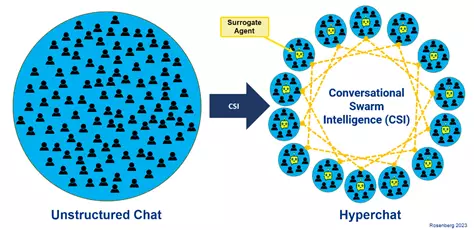In the landscape of modern teamwork, the challenges presented by large group dynamics have remained largely unaddressed—until now. Conventional wisdom suggests that when trying to engage more than a handful of people in a real-time conversation, effectiveness deteriorates, leading to chaos rather than collaboration. Enter the revolutionary concept of conversational swarm intelligence, also known as hyperchat. This technology could very well represent a paradigm shift in how teams brainstorm, deliberate, and execute decisions, pushing the boundaries of what collective intelligence can achieve.
The premise of hyperchat is groundbreaking: imagine a gathering of 200 individuals, each with unique insights and opinions, collectively engaging in meaningful discourse. Traditional formats simply falter as group size increases, resulting in decreased airtime for participants and elevated wait times for responses. Hyperchat disrupts this pattern by employing AI-driven conversational surrogates that break large groups into manageable subunits, facilitating a dialogue that not only preserves individual contributions but also enhances the overall decision-making process.
The Mechanics of Hyperchat
Hyperchat employs a novel approach where AI agents, known as conversational surrogates, accompany each subgroup during discussions. These surrogates distill the key insights and perspectives shared within their respective groups, relaying information dynamically to others in the larger cohort. This framework allows for a cohesive convergence of ideas without losing the richness of individual contributions—essentially weaving together multiple discussions into a single rich tapestry of thought.
While many enterprises have long craved a foolproof method for enacting large-scale real-time deliberations, hyperchat answers that need with remarkable effectiveness. The Thinkscape platform developed by Unanimous AI has already begun to harness this technology, allowing teams to experience a level of interaction that was previously unthinkable.
Real-World Applications: The March Madness Experiment
A notable instance of hyperchat’s capabilities was demonstrated through a recent experiment conducted by Unanimous AI, which assembled 50 random sports fans to collaboratively develop a March Madness bracket in real-time. The results were astonishing. This group, which might normally struggle to achieve any consensus in a typical setting, produced a bracket that performed in the 99th percentile among millions of participants entered into the ESPN contest.
It’s crucial to recognize that the outcome of such an experiment transcends mere luck or coincidence. It signifies an extraordinary synthesis of collective intelligence where individuals, leveraging hyperchat’s framework, can outperform seasoned experts. The potential for generative AI to unlock superior group performance is indeed tantalizing.
Research Underpinnings: A Leap in Cognitive Abilities
The promise of hyperchat is further illuminated by research outcomes that question the traditional metrics of intelligence and group performance. Studies conducted in 2024 between Carnegie Mellon and Unanimous AI revealed a striking difference in scores when groups traditionally assessed through IQ tests were allowed to deliberate in hyperchat. Groups that initially averaged an IQ of 100 exhibited an effective score of 128—indicating a remarkable leap toward gifted-level performance.
In the same vein, collaborative brainstorming conducted within hyperchat environments has demonstrated enhanced feelings of productivity and a deeper sense of ownership over the outcomes. These findings suggest that individuals not only contribute more effectively, but they also become more invested in the ideas being generated, further amplifying the power of collaborative creativity.
Empowering Human-AI Collaboration
Perhaps one of the most exciting prospects of hyperchat is the potential for hybrid collaboration between humans and AI. By introducing an additional type of AI agent known as a “contributor agent,” teams can receive real-time factual content that supports their deliberations. This makes it possible for humans to remain at the helm while AI assists in surfacing relevant knowledge, creating what could be characterized as a “collective superintelligence.”
The implications for industries where swift decision-making is crucial are profound. For Fortune 1000 companies, which often host teams of thousands, hyperchat represents a groundbreaking solution to the perennial bottleneck in decision-making processes. It opens doors to not only more efficient collaboration but also to a future where the decision-making prowess of artificial intelligence can be harnessed while keeping human control intact.
The Path Forward
As the ongoing March Madness tournament illustrates the power of collective intelligence, the potential applications of hyperchat extend far beyond sports fandoms. From corporate strategy meetings to academic collaborations, the ability to integrate AI with human insights could redefine how we approach collective problem-solving on a grand scale. The promise of this transformative technology heralds a new era where unlocking the genius of large groups is no longer a distant dream but an achievable reality.

